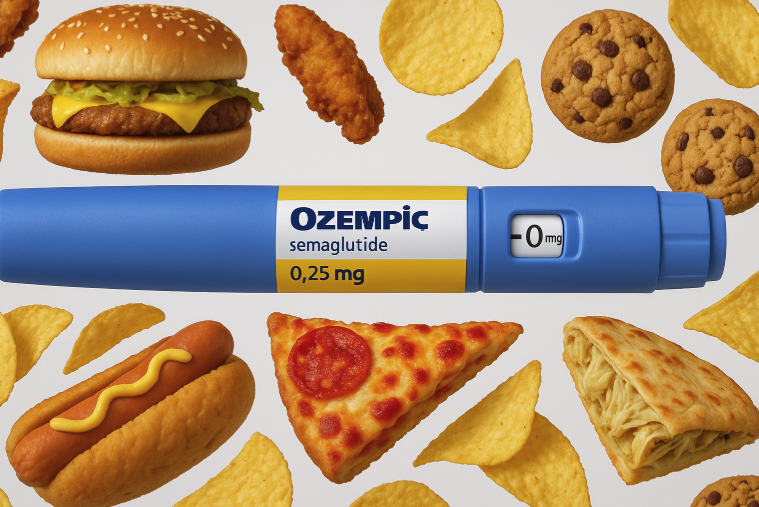Ozempic Is Killing Appetites—Could Big Food Be Pushing Back With Lab-Made Cravings?
Become a paid member to unlock

It’s no secret other nations find the U.S. food industry laughable—bloated portions, chemical-laced snacks, and hyper-processed meals dominate shelves. Many countries have even banned the marketing strategies U.S. food companies employ to promote addictive, obesity-linked products.
But now, that very empire is falling ruin to the weight loss medication craze. An estimated 15.5 million Americans are using Ozempic, Wegovy, Zepbound, and other similar drugs. 24 million Americans may use GLP-1 drugs by 2035, Morgan Stanley projects.
Their appetite-suppressing effects are changing waistlines and gutting profits across food aisles, with patients reporting aversions to processed snacks and sudden healthy food cravings.
"These medications are both a risk and opportunity for the food industry," said Justin Shimek, CEO of food innovation firm Mattson whose clients include PepsiCo, General Mills, McDonald's, and Starbucks, during a webinar. "Clearly, we believe this is going to be a time of disruption."
Shimek's warning isn't hypothetical. A Mattson survey revealed that:
- 66% of GLP-1 drug users are drinking less soda and alcohol
- 93% are eating smaller portions.
- Over 60% say they think about food less.
Mattson is already working with major brands to design products that appeal to this new consumer mindset—think protein-packed bites and easy-to-digest snacks.
But here's the quiet, more insidious aspect to ponder: as Big Food reinvents its products, could it also be exploring ways to counteract the drugs' effects? Could food scientists reverse-engineer a way to make junk food appealing to even Ozempic users?
Neuroscientist Nicole Avena, who studies sugar addiction, told the New York Times it's plausible that food companies could—intentionally or not—engineer products that counteract the effects of GLP-1 drugs. The industry, she noted, has long experimented with powerful reward-triggering compounds designed to keep consumers hooked.
Big Food Has Done This Before
This isn’t the first time America’s food giants have re-engineered their products to meet—and sometimes outmaneuver—a shifting appetite landscape. In the '90s, Big Food pushed fat-free snacks filled with synthetic additives like Olestra, a lab-made fat substitute later linked to digestive distress and vitamin absorption issues. It was part of an era where chemical solutions were rapidly embraced to meet diet fads, often without understanding their long-term consequences.
Industry insiders are watching closely as corporations like Nestlé and General Mills introduce "GLP-1 friendly" frozen meals and protein-based soups. While marketed as helpful, some worry these could be early attempts to re-hack consumer cravings—just as companies once dialed up sugar and salt to hit our brain's bliss points.
Other controversial additives from that still linger in U.S. products today, even as they’ve been banned in Europe. Potassium bromate, a volume enhancer for baked goods, remains legal stateside despite being flagged for potential cancer risks. So do BHA and BHT, synthetic preservatives that scientists have raised alarms about for their possible health effects.
Now, in the Ozempic era, the pivot is already underway. Conagra’s “GLP-1 Friendly” frozen meals are essentially rebranded diet entrees— designed to signal health-conscious intent.
While these products appear supportive, they may also be the earliest phase of a new food arms race: to develop processed items that can once again bypass our satiety cues, even when those cues are medically reinforced.
But today, the tools are more sophisticated. Flavor labs can now amplify sweetness beyond natural limits and deploy masking compounds to hide bitterness or metallic notes.
"In the chemosensory world, almost anything is possible," said Dan Wesson of the Florida Chemical Senses Institute.
Walmart already reports that Ozempic users are buying less, especially in comfort food aisles like baked goods.
Shimek, who takes GLP-1s himself and has lost over 50 pounds, insists there's an honest push for supportive products.
Yet the line between nourishment and manipulation has always been thin—and in America’s Ozempic era, the real question isn’t how we eat, but how far profit-hungry food giants will go to make sure we don’t stop.




